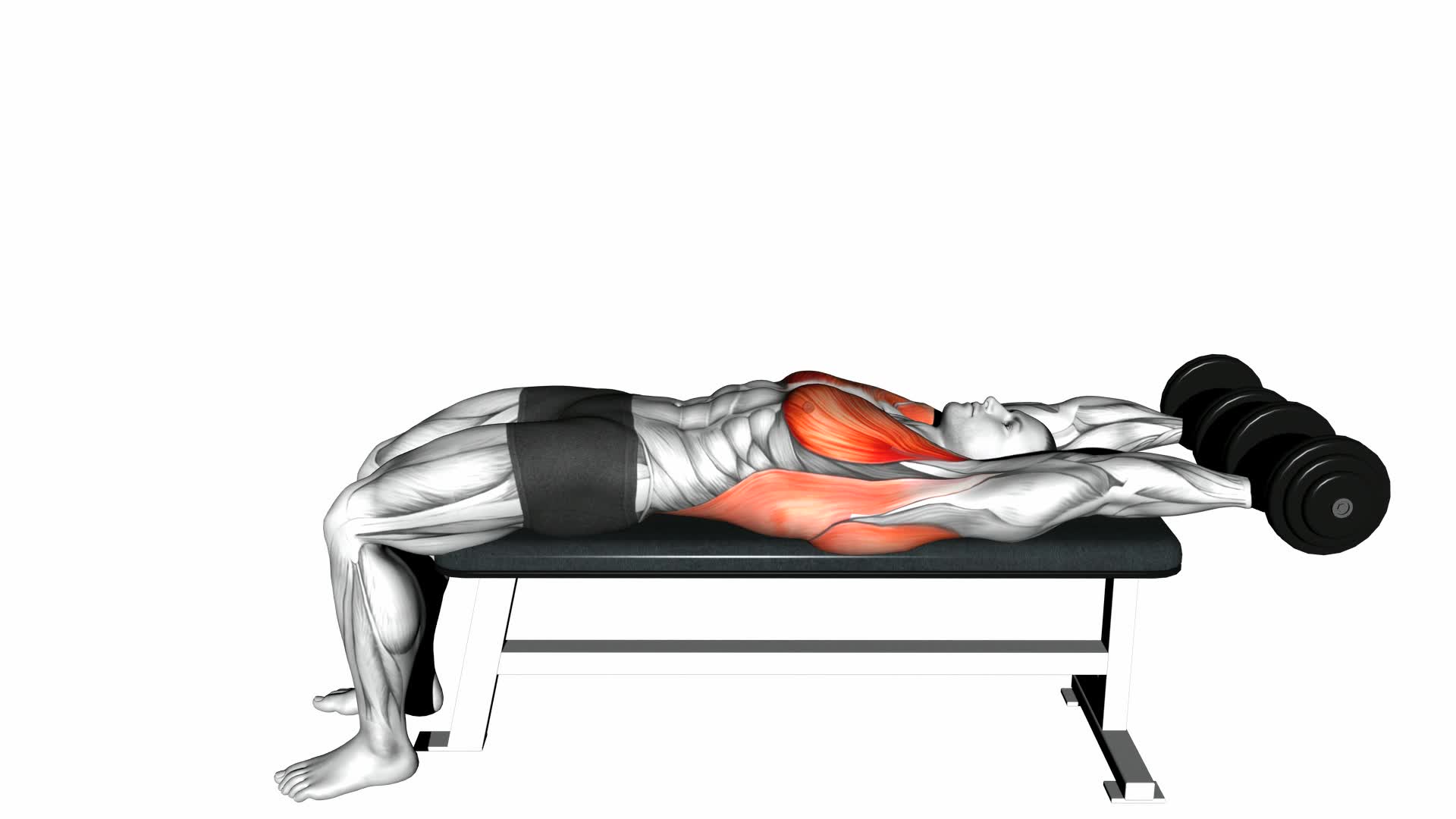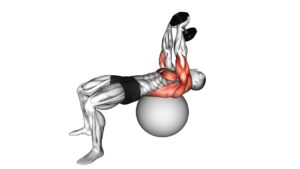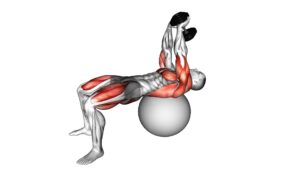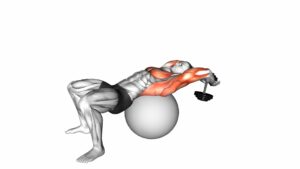Dumbbell Around Pullover – Video Exercise Guide & Tips

Are you looking to strengthen your upper body and improve your posture?
Watch This Exercise Video
The dumbbell around pullover is a fantastic exercise that targets your back, chest, and shoulders.
In this video exercise guide, you'll learn the proper form and technique to maximize your results.
We'll also cover variations, common mistakes to avoid, and important safety precautions.
Get ready to take your fitness to the next level with this effective and versatile exercise.
Let's dive in!
Key Takeaways
- Increased shoulder flexibility and strength
- Targets multiple muscle groups including the back, chest, and shoulders
- Enhances range of motion and flexibility in the shoulder joint
- Activates triceps, chest, and core muscles
Benefits of the Dumbbell Around Pullover
You will experience increased shoulder flexibility and strength when performing the dumbbell around pullover. This exercise is highly effective in improving flexibility and targeting multiple muscle groups.
The dumbbell around pullover primarily focuses on the muscles in your shoulders, including the deltoids, rotator cuffs, and upper back. By engaging these muscles, you can enhance your range of motion and flexibility in the shoulder joint. This is especially beneficial for athletes, weightlifters, and individuals involved in activities that require overhead movements.
In addition to improving flexibility, the dumbbell around pullover also works other muscle groups such as the triceps, chest, and core. As you perform the exercise, your triceps and chest muscles are engaged to stabilize the movement and support the shoulder muscles. Your core muscles are also activated to maintain proper posture throughout the exercise.
Proper Form and Technique
To perform the dumbbell around pullover with proper form and technique, correct posture is of utmost importance.
Maintaining a neutral spine and engaging your core will help protect your back and prevent injury.
It's also crucial to avoid common mistakes such as using momentum or swinging the weights, as this can compromise the effectiveness of the exercise and increase the risk of strain or muscle imbalances.
Correct Posture Importance
Maintaining proper form and technique is crucial for achieving optimal results during the Dumbbell Around Pullover exercise. To ensure correct posture, consider the following:
- Importance of alignment: Align your body properly to engage the correct muscles and prevent strain. Keep your spine neutral and shoulders relaxed.
- Common postural issues: Be mindful of common issues such as rounded shoulders or excessive arching of the lower back. These can affect the effectiveness of the exercise and increase the risk of injury.
- Engage your core: Activate your core muscles throughout the exercise to stabilize your body and maintain proper alignment.
- Control your breathing: Breathe deeply and exhale as you extend the dumbbell overhead and inhale as you bring it back to the starting position.
By focusing on correct posture and technique, you can maximize the benefits of the Dumbbell Around Pullover exercise.
Now, let's explore how to avoid common mistakes in the next section.
Avoiding Common Mistakes
To ensure proper form and technique, it's important to be aware of common mistakes that can occur during the Dumbbell Around Pullover exercise.
One common mistake is using too heavy of a weight, which can lead to loss of control and potential injuries. It's crucial to choose a weight that allows you to maintain proper form throughout the exercise.
Another mistake is overextending the shoulders or arching the back excessively, which can strain the muscles and increase the risk of injury. To prevent this, focus on keeping your shoulders stable and maintaining a slight bend in your elbows.
Lastly, avoid rushing through the exercise and prioritize slow, controlled movements to maximize the benefits and minimize the risk of injury.
Now, let's move on to discussing variations and modifications for the Dumbbell Around Pullover.
Variations and Modifications
Try different dumbbell weights to find the right level of challenge for you. Here are some variations and modifications you can try to switch up your dumbbell around pullover routine:
- Equipment options: Instead of using dumbbells, you can use a barbell or resistance bands to perform the around pullover exercise. These alternatives can provide a different feel and target your muscles in a slightly different way.
- Muscle targeting: To focus more on your chest muscles, you can perform the dumbbell around pullover on an incline bench. This will increase the activation of your pectoral muscles. On the other hand, if you want to target your back muscles more, you can perform the exercise on a decline bench.
- Single-arm variation: Instead of using both arms simultaneously, you can perform the exercise with one arm at a time. This won't only challenge your muscles in a different way but also help improve your stability and balance.
- Tempo variations: Experiment with different tempos during the exercise. You can slow down the eccentric (lowering) phase to increase the time under tension and focus on muscle endurance. Alternatively, you can perform explosive concentric (lifting) movements to enhance power and explosiveness.
Common Mistakes to Avoid
To maximize the effectiveness and safety of your dumbbell around pullover, it's crucial to avoid common mistakes. Incorrect form can lead to injuries, so make sure to maintain proper technique throughout the exercise.
Overloading without proper guidance can also put excessive strain on your muscles and joints, so start with a weight that challenges you but allows for proper form.
Incorrect Form Dangers
Avoiding incorrect form dangers is crucial when performing the dumbbell around pullover exercise. Common form mistakes can lead to injuries, so it's important to be aware of them and take the necessary precautions to prevent them. Here are four common form mistakes to avoid:
- Arching your back excessively: This can strain your lower back and lead to discomfort or injury. Keep your back flat on the bench throughout the exercise.
- Dropping the dumbbell too low: Lowering the dumbbell too far behind your head can put excessive stress on your shoulders and increase the risk of injury. Keep the dumbbell at a comfortable distance from your head.
- Using too much weight: Using weights that are too heavy can compromise your form and increase the risk of injury. Start with lighter weights and gradually increase as you become more comfortable with the exercise.
- Failing to engage your core: Neglecting to engage your core muscles can put unnecessary strain on your lower back. Keep your core tight and engaged throughout the exercise to maintain proper form and prevent injury.
Overloading Without Guidance
When you overload without guidance, you risk making common mistakes that can lead to injuries during the dumbbell around pullover exercise. Overloading refers to using too much weight or pushing yourself beyond your limits without proper instruction. This can put excessive strain on your muscles, joints, and connective tissues, increasing the risk of sprains, strains, and even tears.
To prevent injury, it's important to follow guidelines for progressively increasing the weight and intensity of your workouts. Start with a weight that allows you to maintain proper form and gradually increase it as you become stronger and more comfortable with the exercise. Additionally, listen to your body and rest when needed to avoid overtraining or overuse injuries.
Taking these precautions will help you safely maximize the benefits of the dumbbell around pullover exercise while minimizing the risk of injury.
Skipping Warm-Up Precautions
Make sure you warm up properly before attempting the dumbbell around pullover exercise. Skipping warm-up precautions can put you at risk of injury and hinder your workout progress.
Here are four common mistakes to avoid when it comes to skipping warm-up:
- Ignoring muscle activation: Skipping warm-up means you're not properly activating the muscles you'll be using during the exercise. This can lead to strains and pulls.
- Decreased range of motion: Without a proper warm-up, your joints and muscles may not be adequately prepared for the movements involved in the dumbbell around pullover exercise. This can lead to limited range of motion and potential injuries.
- Lack of blood flow: Warm-up exercises increase blood flow, delivering oxygen and nutrients to the muscles. Skipping warm-up can reduce blood flow and hinder muscle performance.
- Increased risk of injury: Without a warm-up, your muscles and connective tissues are more prone to injury. Skipping this crucial step can lead to sprains, strains, and other painful conditions.
Taking the time to warm up properly before attempting the dumbbell around pullover exercise is essential for injury prevention and optimal performance. Don't underestimate the importance of a good warm-up routine.
Tips for Maximizing Results
To maximize your results, focus on maintaining a strong grip on the dumbbell throughout the entire around pullover exercise. This exercise targets your chest, shoulders, and back, and a strong grip ensures that you're effectively engaging these muscles.
In addition to a strong grip, there are a few other tips to help you maximize your results.
Firstly, staying motivated is crucial for achieving your fitness goals. Set small, achievable goals and celebrate your progress along the way. Keep in mind that results won't happen overnight, so be patient with yourself and stay committed to your workout routine.
Secondly, tracking your progress is essential for staying on track and monitoring your improvements. Keep a workout journal or use a fitness tracking app to record your sets, reps, and weights used. By tracking your progress, you can see how far you've come and make adjustments to your workout routine as needed.
Lastly, don't be afraid to challenge yourself. As you become stronger, gradually increase the weight of the dumbbell or add more repetitions to your sets. Pushing yourself outside of your comfort zone will help to stimulate muscle growth and ensure you continue to see progress.
Safety Precautions and Considerations
To ensure your safety during the dumbbell around pullover exercise, it's important that you maintain proper form and use a weight that you can comfortably handle. Here are some safety precautions and considerations to keep in mind:
- Warm up: Before starting any exercise, it's crucial to warm up your muscles to prevent injuries. Spend a few minutes doing light cardio exercises or dynamic stretches to increase blood flow and prepare your body for the workout.
- Proper form: When performing the dumbbell around pullover, maintain a neutral spine and engage your core muscles. Avoid arching your back or straining your neck. Keep your movements controlled and smooth to avoid any jerking or swinging motions.
- Gradual progression: Start with a lighter weight and gradually increase the resistance as your strength and form improve. Pushing yourself too hard or using weights that are too heavy can lead to muscle strains or other injuries.
- Equipment usage: Make sure the dumbbells you're using are in good condition and have a secure grip. Check for any signs of wear or damage before each use. Additionally, use a stable bench or exercise mat to support your body during the exercise.
Frequently Asked Questions
How Many Sets and Repetitions Should I Do for the Dumbbell Around Pullover Exercise?
To get the most out of the dumbbell around pullover exercise, it's important to know how many sets and repetitions to do. Incorporating this exercise into your workout routine has many benefits, such as targeting your chest, shoulders, and back muscles.
However, it's crucial to avoid common mistakes like using too much weight or improper form.
Can I Use a Resistance Band Instead of Dumbbells for This Exercise?
Yes, you can use a resistance band instead of dumbbells for the dumbbell around pullover exercise. While using a resistance band can provide a similar movement, using dumbbells offers additional benefits.
Dumbbells allow for more resistance and can help build muscle strength more effectively. They also provide a greater range of motion, allowing you to target specific muscle groups more efficiently.
However, if you don't have access to dumbbells, a resistance band can still be a viable alternative.
Should I Perform This Exercise on an Incline Bench or a Flat Bench?
To perform the dumbbell around pullover exercise, you have two options: using an incline bench or a flat bench. The choice depends on your fitness goals and personal preference.
The incline bench targets your upper chest and shoulders more, while the flat bench focuses on your entire chest and back. Both variations provide a great workout for your upper body.
Experiment with both to see which one works best for you.
Can Beginners Perform the Dumbbell Around Pullover Exercise?
As a beginner, you may wonder if you can perform the dumbbell around pullover exercise. The answer is yes, you can!
To modify this exercise for beginners, start with a lighter weight and focus on perfecting your form. Keep your core engaged and avoid arching your back.
Also, make sure to start with a comfortable range of motion and gradually increase it over time.
Is It Necessary to Use a Spotter When Performing This Exercise?
Yes, it's necessary to use a spotter when performing the dumbbell around pullover exercise. This exercise requires proper form and technique to avoid injury.
A spotter can help ensure that you maintain the correct posture and control throughout the movement. Additionally, using a spotter can provide an extra layer of safety in case you struggle with the weight or need assistance during the exercise.
The dumbbell around pullover targets the upper body muscles, including the chest, back, and shoulders.
Conclusion
In conclusion, the dumbbell around pullover exercise is a highly beneficial workout that targets multiple muscle groups. By following proper form and technique, variations and modifications can be made to suit individual fitness levels.
It's important to avoid common mistakes and maximize results by incorporating tips such as proper breathing and gradually increasing weights. Safety precautions should always be taken into consideration to prevent injuries.
Incorporating the dumbbell around pullover into your fitness routine can help you achieve your strength and fitness goals.

Author
Years ago, the spark of my life’s passion ignited in my mind the moment I stepped into the local gym for the first time. The inaugural bead of perspiration, the initial endeavor, the very first surge of endorphins, and a sense of pride that washed over me post-workout marked the beginning of my deep-seated interest in strength sports, fitness, and sports nutrition. This very curiosity blossomed rapidly into a profound fascination, propelling me to earn a Master’s degree in Physical Education from the Academy of Physical Education in Krakow, followed by a Sports Manager diploma from the Jagiellonian University. My journey of growth led me to gain more specialized qualifications, such as being a certified personal trainer with a focus on sports dietetics, a lifeguard, and an instructor for wellness and corrective gymnastics. Theoretical knowledge paired seamlessly with practical experience, reinforcing my belief that the transformation of individuals under my guidance was also a reflection of my personal growth. This belief holds true even today. Each day, I strive to push the boundaries and explore new realms. These realms gently elevate me to greater heights. The unique combination of passion for my field and the continuous quest for growth fuels my drive to break new ground.







